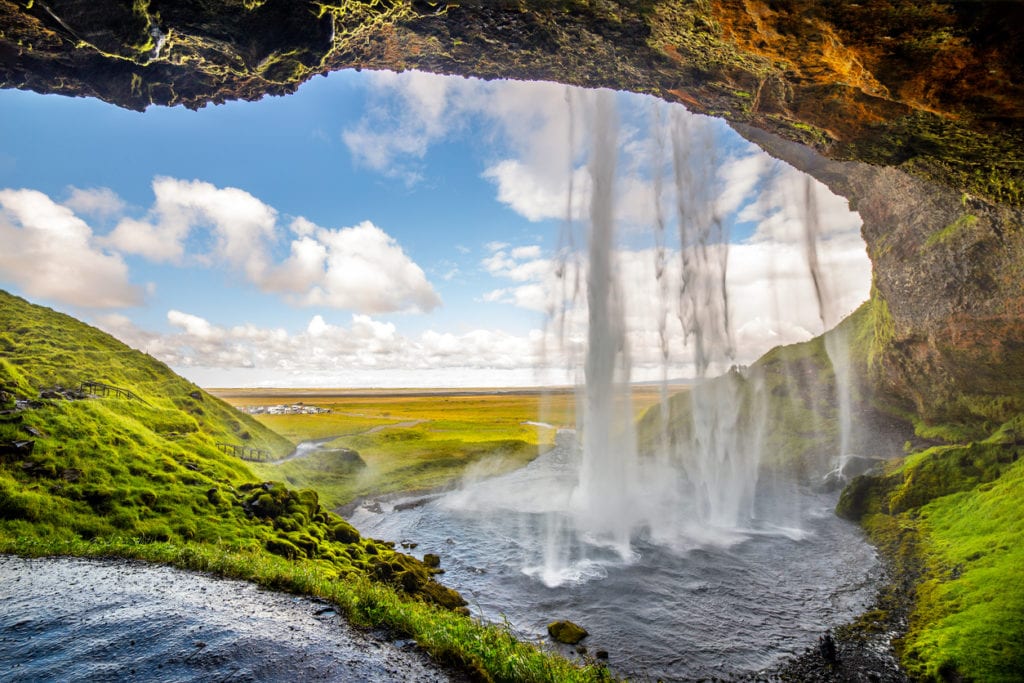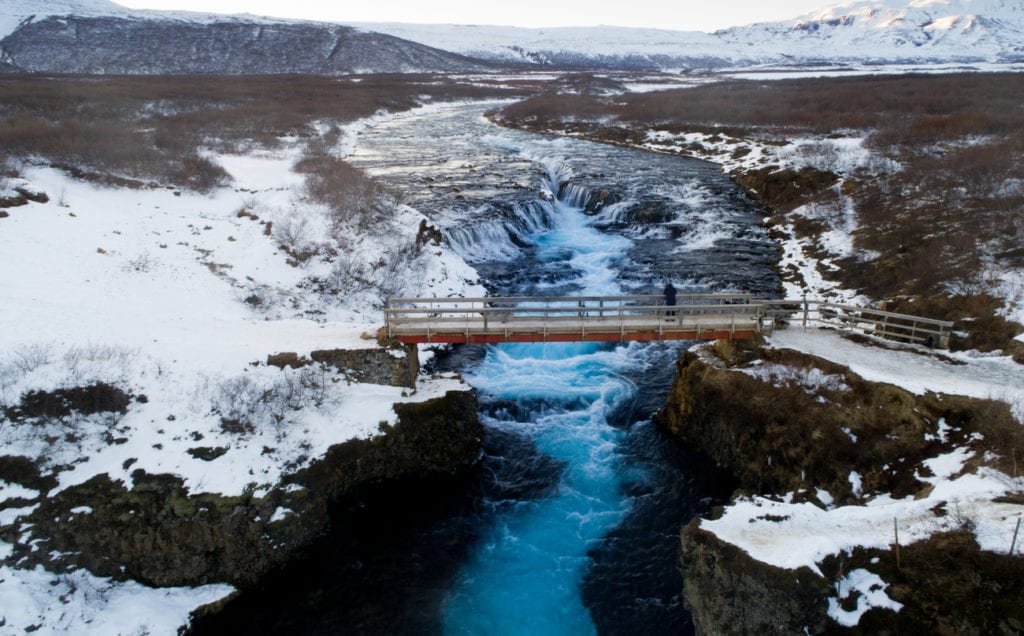Iceland is a beautiful country. Most people start their exploration with the Golden Circle – Thingvellir National Park, Geysir geothermal field and, of course, one of the many waterfalls in Iceland, the Gullfoss Waterfall.
However, Iceland has a lot more waterfalls than that. A lot more. The climate, which produces a lot of precipitation, combined with glaciation and tectonic activity that creates fault lines, resulting in thousands of waterfalls. Some of them don’t have names. Some of them are world-famous. There is literally no way to see all of them, even if you plan an entire trip just around waterfall chasing. They vary in size and type, and many are quite photogenic. If renting a car, you should put at least some of these amazing falls on your list.
Here are some other waterfalls in Iceland:
Gullfoss
One of the more famous waterfalls in Iceland, a tourist trap, but it’s also an Iceland icon. If you’re doing the Golden Circle you will hit it. As a pro tip (and for some of the other waterfalls), bring a slicker or rain jacket. Some of the best viewing points are well within the spray zone and if it’s not a particularly warm day, you will be glad of some protection (you may want it at Geysir too). The waterfall has two tiers totalling 32 metres in height and is spectacular. However, it’s also the best known. Everyone wants to see it and it can get crowded. So, perhaps we should move on.
Godafoss
The “Waterfall of the Gods,” supposedly because some chieftain threw idols of the Norse Gods into it when he converted. However, it deserves the name for other reasons. If you want to see a classic “horseshoe” fall, this is your one. It’s on the Diamond Circle tourist route, which is in north of Iceland and is less well known (and thus less trafficked) than the Golden Circle. The route starts in Husavik, one of the best places in the world for whale watching, and includes another waterfall, a geothermal area, volcanic fields, and other amazing attractions. The fall is close to the Ring Road, and an easy half kilometer walk from the parking lot.
Dettifoss
Also on the Diamond Circle (at this point, you should have worked out that “foss” is Icelandic for “waterfall), Dettifoss is the biggest waterfall in Europe measured by water volume. Be aware that the road from Asbyrgi to the falls, although rated for ordinary cars, is often closed at any time other than summer. Check first. It’s a gravel road, so be careful. There’s also a paved road from route one, which is closed January through April. If you have more time, there is a 34km (about 21 miles) hiking route from Dettifoss along the river to Asbyrgi. The sheer size of this waterfall is what makes it worth visiting. 500 cubic meters of water…per second.
Seljalandsfoss

If you’re driving in the south of Iceland and just want a quick stop, you can pull off at Seljalandsfoss, a 63m/213ft waterfall that’s about ninety minutes south of Reykjavik. You can actually see it from the road. Go early or late in the day to avoid throngs of tourists. The fall’s size and accessibility make it possibly the most visited waterfalls in Iceland. The fall is narrow and tall and you can actually get an angle from behind, without having to walk all the way under the falls. This is a classic tourist shot, but worth it.
Skogafoss
A bit further along the ringroad, you will find Skogafoss, which is a little more of a hike to reach. However, you can get right to the bottom of the falls (another place for that raincoat). A trail leads up the right-hand side of the waterfall and continues along the river. You can camp nearby, or just appreciate the ability to get up close and personal with this gorgeous fall. If it’s a sunny day, get out your camera and try to capture the rainbow made by the falls. In some cases, it can make a double rainbow, although those are very hard to capture.
Faxafoss
If you have extra time on the Golden Circle, especially around lunchtime, head to Faxafoss. It’s a wide fall, just southwest of Gullfoss, and has picnic facilities and, rumor has it, a good restaurant. In late summer and fall, the salmon run here, which is well worth seeing. It’s also called Vatnsleysufoss, implying that it lacks water, but this may be an artifact of a drier past.
Aldeyjarfoss
You’ll find this one in north Iceland, one of a series of three falls on the Skjálfandafljót river. It’s technically in the Highlands, on the Sprengisandur Highland Road, so may not be accessible except in summer. The reason to see this one is that it flows over black basalt, making a spectacular contrast that can lead to some awesome photography. The other falls are Godafoss and Hrafnabjargafoss. Plan a trip to see all three of these marvelous cascades.
Svartifoss
Again, this one flows over black basalt. The base of the fall is marked by fallen basalt columns, and the entire thing has a slight resemblance to a Minecraft build. The columns in Hallgrimskirkja in Reykjavik (the big Lutheran church that provides a great landmark when walking through the city) were inspired by the columns here. It’s located in Skaftafell National Park, and you may want to plan for at least a day here. The park has no roads, but you can park at the Visitors Centre and follow one of a huge network of hiking trails, choosing your own length. If you want more information about your surroundings, there are regular guided tours offered by the park wardens. The park is off the ring road in south Iceland.
Glymur
If you are up for a hike, the second tallest of the waterfalls in Iceland (almost 200 meters tall) is surprisingly close to Reykjavik. The round trip from the parking lot is four to five hours and is not an easy hike. If you are uncomfortable with heights you might want to skip it, as parts have dizzying drops and you have to cross the river on a log with a steel wire above it. You might want to consider walking poles for this one and watch out for offshoot trails. Glymur is on the Snaefellsnes Peninsula, which is sometimes missed by people driving the Ring Road but contains some amazing sites and hiking routes.
Hraunfossar
In total contrast, Hraunfossar is a series of small waterfalls in Iceland that flow over a lava field. It’s a beautiful site, but be careful. People, especially children, have been known to fall in after getting too close to the falls. Barnafoss is just above Hraunfossar, so this is a two for one. It is easy to access from the parking lot and is found in the Borgarfjordur district in west Iceland, which also contains the historically important town of Reykholt and some awesome opportunities for salmon fishing in season.
Barnafoss

Barnafoss means “Children’s Falls” and is named after a folk legend where two children fell off the bridge above the waterfall and died, and their mother apparently went insane. The bridge is no longer there, thanks to Iceland’s heavy seismic activity. The story may have some truth to it, or it may have been a tale told to get kids to be careful around waterfalls… The small, rapid waterfall is pretty and well worth a visit.
Kirkjufellsfoss
This is one of the smaller waterfalls in Iceland, but it’s charming and if you get your angle right you can catch Mount Kirkjufell in the background, a spectacular volcanic cone that looms against the sky. The best time to come is at enight in the middle of summer, when the low light of the midnight sun produces a beautiful effect. It’s also on the Snaefellsnes peninsula and is yet another great reason to extend your trip to cover this beautiful area of Iceland.
Bruarfoss
This one is in southwest Iceland, on the Brúará river, and is not well known. The secret should be out though, although this is a small fall, the water is cobalt blue. You may have it to yourself even in the height of summer. Enjoy this hidden gem. You can take a detour from the Golden Circle between Thingvellir and Geysir. It can be a little hard to find. Look for the blue sign about halfway between Laugarvatn and Geysir. The trail to the fall is muddy, so wear your boots. As an alternative, a nearby farm hotel, Efstidalur, offers a two hour horseback riding excursion that apparently goes to the falls, although you should check with them as this information came from a review.
Halfoss and Granni
Last but not least, Halfoss is another high fall that is near Arnes, east of Reykjavik. Be aware that the access road is gravel, it turns off just before the Sultartangi power plant. You can actually get both Halfoss and Granni in the same view if you know where to stand. The two falls are on the Fossa and Thorsa rivers where they join. Be aware that the top of the falls may not be a great spot for people afraid of heights. The canyon is overall spectacular and well worth a visit.
Learn More About the Waterfalls in Iceland
Of course, there are many, many more waterfalls, and you may find random ones driving the ring road. If you stop at all of them, you will never reach your destination. Iceland is a waterfall country and the opportunities for awesome photography and great river hikes are endless. Find more articles to inspire your travel in Iceland here, and note that renting a car is the best way to see and discover hidden gems.
Back